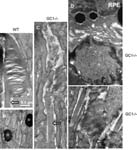Phenotypes associated with this allele
|
|
| Find Mice |
Using the International Mouse Strain Resource (IMSR)
Mouse lines carrying:
Gucy2etm1Gar mutation
(1 available);
any
Gucy2e mutation
(45 available)
|
|
|

Ultrastructure of wild type and degenerative Gucy2etm1Gar/Gucy2etm1Gar cone outer segments
vision/eye
|
|
• at distal connecting cilia, membrane components are partitioned into layered stacks
|
|
|
• apical inner segments of cones appear retracted from connecting cilia and surrounded by extracellular blebs
|
|
|
• at 2 months of age, cone outer segments (COS) in retinas are extremely disorganized
|
|
|
• in severely degenerated cases, membranes are detached
|
|
|
• sensitivity of rods to light (half-saturating flash intensity of 13.6 photons/um2) is 3.5-fold higher than wild-type
|
|
|
• scotopic a- and b-wave amplitudes in 4-6 week old mice are significantly reduced compared to wild-type responses
• after exposure to high intensity light, followed by 1 hour of dark adaptation, a-wave amplitude recovery is delayed relative to wild-type, with only 30% recovery
|
nervous system
|
|
• at distal connecting cilia, membrane components are partitioned into layered stacks
|
|
|
• apical inner segments of cones appear retracted from connecting cilia and surrounded by extracellular blebs
|
|
|
• at 2 months of age, cone outer segments (COS) in retinas are extremely disorganized
|
|
|
| Find Mice |
Using the International Mouse Strain Resource (IMSR)
Mouse lines carrying:
Gucy2etm1Gar mutation
(1 available);
any
Gucy2e mutation
(45 available)
|
|
|
vision/eye
|
|
• by 5 weeks of age, number of identifiable cones is dramatically reduced
|
|
|
• cells degenerate rapidly at 4-5 weeks of age, with few surviving at late stages
|
|
|
• by 1 month of age, electroretinograms (ERG) of mutant mice are abnormal
|
|
|
• at one month of age, cone responses to flashes in rod-saturating background are barely detectable
|
|
|
• rod a-wave and b-wave of ERG are severely reduced at one month of age
• flash response from a rod demonstrates increased time-to-peak before decaying more rapidly than in controls; rods have a higher sensitivity than wild-type
• rods show oscillations during and after recovery from a light flash
|
nervous system
|
|
• by 5 weeks of age, number of identifiable cones is dramatically reduced
|
|
|
• cells degenerate rapidly at 4-5 weeks of age, with few surviving at late stages
|
vision/eye
|
|
• 6 month old mice have fewer cones in the inferior versus superior retinas
|
|
|
• outer nuclear layer (ONL) is 28% thinner than in single Nrl homozygotes at 6 months of age
• treatment with an adenovirus expressing Gucy2e results in cone preservation with increased ONL thickness
|
|
|
• ERG indicates no discernible wave forms, with no M-cone or S-cone responses
• subretinal injection of an adenovirus expressing Gucy2e at around P41, but not at P18, fully restores retinal function and useful vision over the long-term
• mice treated with an adenovirus expressing human GUCY2D at P40 exhibit restored retinal function
|
behavior/neurological
|
|
• visually guided behavior testing (optokinetic reflex) shows decreased cone-mediated spatial frequency thresholds at 6 months of age
|
homeostasis/metabolism
nervous system
|
|
• 6 month old mice have fewer cones in the inferior versus superior retinas
|
|
|
| Find Mice |
Using the International Mouse Strain Resource (IMSR)
Mouse lines carrying:
Gucy2etm1Gar mutation
(1 available);
any
Gucy2e mutation
(45 available)
Gucy2ftm1Wbae mutation
(0 available);
any
Gucy2f mutation
(4 available)
|
|
|

Abnormal rod outer segments in Gucy2etm1Gar/Gucy2etm1Gar Gucy2ftm1Wbae/Gucy2ftm1Wbae mice
vision/eye
 |
• retinas have slightly decreased cone numbers relative to controls
|
 |
• at 2 months of age, outer segment lengths are ~50-70% of normal
|
 |
• cone cell remnants are identified in the retina, but outer segments are absent
|
 |
• cone degeneration is most severe inferior to the optic nerve
|
 |
• complete lack of cGMP
• rods are surrounded by blebs in interphotoreceptor matrix
|
 |
• at 6 months of age, rod outer segments are severely reduced in superior/inferior and nasal/temporal quadrants
• in retina, rod outer segments are shorter and narrower than in wild-type, and appear banded by alternating regions of dense membrane layers and lumen-containing tubules
|
 |
• at 6 months of age, outer nuclear layer (ONL) contains only 4-6 rows of nuclei
|
 |
• scotopic electroretinographic responses are absent in all double homozygotes
• no detectable light-sensitive current is detectable in rods
• after exposure to high intensity light, followed by 1 hour of dark adaptation, a-wave amplitude recovery is completely absent in mutants compared to 70% recovery in wild-type
|
nervous system
 |
• retinas have slightly decreased cone numbers relative to controls
|
 |
• at 2 months of age, outer segment lengths are ~50-70% of normal
|
 |
• cone cell remnants are identified in the retina, but outer segments are absent
|
 |
• cone degeneration is most severe inferior to the optic nerve
|
 |
• complete lack of cGMP
• rods are surrounded by blebs in interphotoreceptor matrix
|
 |
• at 6 months of age, rod outer segments are severely reduced in superior/inferior and nasal/temporal quadrants
• in retina, rod outer segments are shorter and narrower than in wild-type, and appear banded by alternating regions of dense membrane layers and lumen-containing tubules
|



 Analysis Tools
Analysis Tools
